AMD Ryzen 9 6900HS review: Game-changing performance for tiny laptops
We’ll understand if you assumed AMD was toast when Intel unleashed its spectacularly fast 12th-gen “Alder Lake” laptop CPUs in January. AMD, however, ain’t just giving up. In fact, its new Ryzen 6000-series CPUs and Radeon RX 6800S GPU are direct proof that the battle for laptop supremacy will continue to be a knock-down, drag-out brawl between chip makers.
The Ryzen 6000-series laptop processors, announced at CES 2022, are based the company’s Zen 3+ core (an upgraded version of the architecture found in AMD’s stunning Ryzen 5000 desktop processors) and built on an improved 6nm TSMC process. Inside the core, not much has changed all that much from the awesome-sauce Zen 3 from a performance perspective.
There’s more than one way to skin a CPU though. Instead of changing the design of the core, AMD mostly aims to pick up performance by greatly increasing its power efficiency. So much so that the company claims the new Ryzen 6000 is “most efficient x86 CPU” in town. And that focus on efficiency winds up making the thin, light Ryzen 9 6800HS gaming laptop we’re testing today go toe-to-toe with significantly chunkier gaming laptops in raw performance, bolstered by the similarly energy-efficient Radeon RX 6800S GPU—a truly impressive spectacle indeed.
Apple fans will note the statement of “most efficient x86 CPU” leaves Apple’s M1 chips out of the conversation but that’s a discussion for another day. Today, AMD is focused solely on continuing to peel off sales from Intel’s new 12th-gen CPUs. AMD success in laptops (an area Intel has long ruled) has been nothing short of phenomenal recently so there’s a lot riding on just how well Ryzen 6000 does. Do the Ryzen 6900HS and Radeon RX 6800S keep AMD in the game against Intel’s excellent Alder Lake? Spoiler alert: Yep. Let’s go.
How we tested
Our testing platform for AMD’s new Ryzen 9 6900HS and Radeon RX 6800S comes to us in the form of the upgraded Asus ROG Zephyrus G14 (2022). The laptop selection is fitting, as the introduction of the original ROG Zephyrus at CES 2020 really helped put AMD’s mobile Ryzen push in motion. At the time, Intel’s best comparable CPUs ran too hot to squeeze into thin and light laptops, leaving the debut ROG Zephyrus G14 with its Ryzen 9 4900HS to crush all comers at the time, despite being nearly half a pound lighter.
This new ROG Zephyrus G14 is just as impressive with its 3.6 pound weight, 8-core Ryzen 9 6900HS, new Radeon RX 6800S discrete graphics, 32GB of DDR5/4800, and an eye-catching 14-inch 16:10 2560 x 1600 resolution screen, blazing at an impressive 500 nits. The compact powerhouse laptop also features a vapor chamber cooling design to help share power between the CPU and GPU, which both use liquid metal instead of standard thermal paste as well. The laptop, and all of the others we tested below, was running the latest version of Windows 11. We opted, however, to leave Microsoft’s Virtual Based Security feature turned off. It increases security but can at times eat some performance. The Windows 11 OEM power/performance slider was set to the highest state available for all laptops.
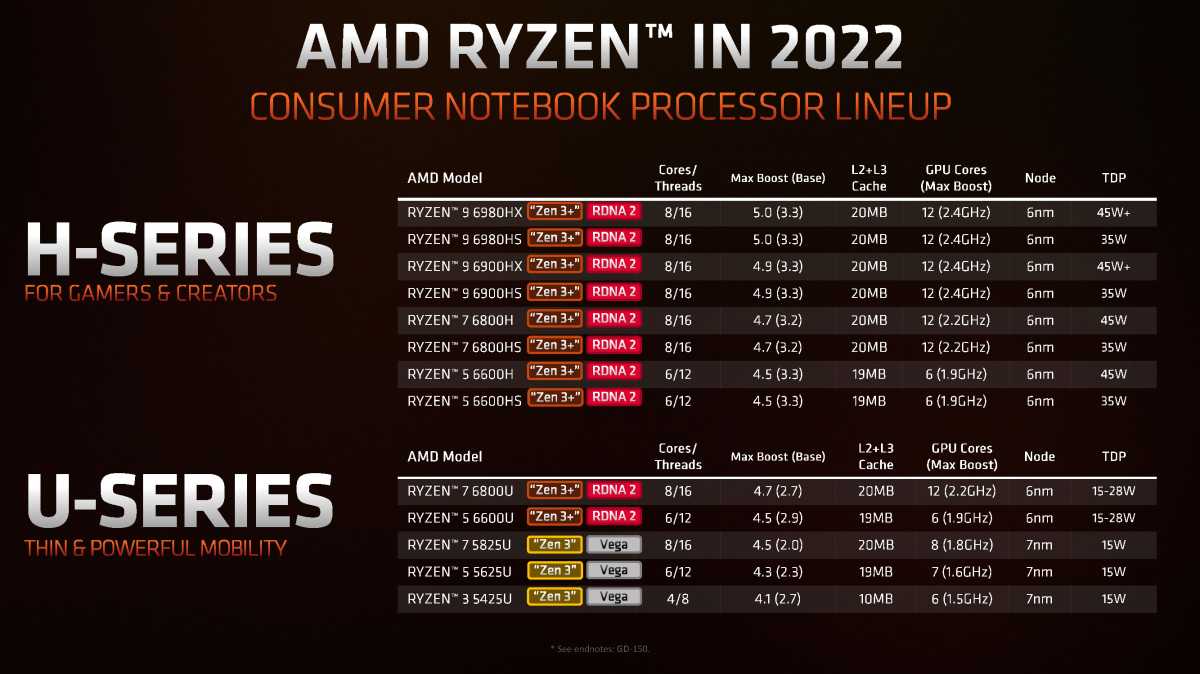
All testing was conducted while plugged in, and for gaming, discrete graphics modes were selected where available.
Performance on battery will be a topic for later testing, but just know that AMD has said that Ryzen 6000’s performance on battery can be as good as while plugged-in. This has been a problem for AMD processors, which have tended to end up in laptops that saw performance nose dive while on battery. We did run Cinebench R20 both plugged and unplugged, and found the performance to be identical, but we should note Asus ROG Zephyrus G14 doesn’t allow access to its “Turbo” setting when unplugged, so we used the “Performance” preset for that experiment.
We’re comparing the Asus ROG Zephyrus G14 with its all-AMD loadout against a wide selection of rival laptops:
- MSI GE76 Raider with a 14-core 12th-gen Intel Core i9-12900HK, Nvidia GeForce RTX 3080 Ti Laptop GPU with a 175 watt TGP, 32GB of DDR5/4800, 2TB PCIe Gen 4 SSD, 17.3-inch 1080p 360Hz panel and 280 watt power brick. The laptop itself weighs 6.4 pounds.
- MSI Prestige 14 Evo with a 4-core 11th-gen Intel Core i9-1195G7, Iris Xe integrated graphics, 16GB of LPDDR4X/4266 RAM, 1TB PCIe Gen 4 SSD, 14-inch 1080p screen and 65 watt power brick. The laptop weighs 2.8 lbs.
- XPG Xenia 15KC with an 8-core 11th-gen Intel Core i7-11800H, Nvidia GeForce RTX 3070 Laptop GPU with a 140 watt TGP, 32GB of DDR4/3200, 1TB PCI Gen 4 SSD, 15.6-inch, 2650×1600, 165Hz screen and 230 watt power brick. The laptop weighs 4 lbs.
- Asus ROG Zephyrus G14 GA401 with 8-core Ryzen 9 4900HS, Nvidia GeForce RTX 2060 Max-Q GPU, 24GB of DDR4/3200, 1TB PCIe Gen 3 SSD, 14-inch, 1080p, 120Hz screen and 180 watt power brick. The laptop weighs 3.6 pounds. The laptop actually comes with 16GB of RAM, but we decided to add additional RAM to bring it to 24GB to give it a better chance when running against most of the other laptops with 32GB of RAM.
- Asus ROG Flow X13 with 8-core Ryzen 9 5980HS, Nvidia GeForce RTX 1650 Max-Q GPU, 32GB of LPDDR4X/4266, 1TB PCIe Gen 3 SSD, 13.4-inch, 3480×2400 resolution touch screen and 100-watt power brick. The laptop weighs 2.9 pounds.
- Asus ROG Zephyrus G14 GA402 with 8-core Ryzen 9 6900HS, AMD Radeon RX 6800S, 32GB of DDR5/4800, 1TB PCIe Gen 4 SSD, 14-inch 2560×1600 500 nit screen with a refresh of 165Hz and 240 watt power brick. The laptop weighs 3.8 pounds with its miniLED Anime Matrix lid.
- Asus ROG Strix Scar G17 with 8-core Ryzen 9 5900HX, Nvidia GeForce RTX 3080 Laptop GPU with a 130 watt TGP, 32GB of DDR4/3200, 2TB PCIe Gen 3 SSD, and 17.3-inch 1080p 360Hz screen. The laptop weighs 6 pounds.
Before we start, we want to remind you that looking at CPU and GPU performance in laptops isn’t the same as in a desktop, where you can control the cooling and power. Laptops are fully integrated platforms, and performance can indeed vary based on the engineering and business decisions made on each and every laptop model. That, however, can’t turn a really slow CPU or GPU into a really fast one.
Still, you should consider the influence that every laptop design has on the chips inside of it. For example, our tested laptops include results from models that weigh up to 6.4 pounds and feature 280 watt power-bricks and 17.3-inch screens. That’s significantly more room for cooling the CPU and GPU than you’d get in a smaller laptop, such as this new ROG Zephyrus G14. So just remember to factor in the size and weight of the laptop when looking at the performance scores below—a key consideration since our only 12th-gen Core “Alder Lake” specimen comes in the form of the beefy MSI GE76 Raider, with Intel’s flagship Core i9-12900HK inside (complete with a mixture of high-power and high-efficiency cores).
3D rendering performance
We’ll kick this off where we often do, in Maxon’s popular Cinebench R23 test. It’s a benchmark built around the same 3D rendering engine found in Maxon’s commercial Cinema 4D application, which is also integrated into such applications as Adobe’s After Effects. It’s used for 3D modeling and scales quite well with core and thread count. Basically, the CPU with the most cores and highest sustained clocks under load usually wins.
The winner, no surprise, is the beefy GE76 Raider with its 14-core Core i9-12900HK CPU in it. Intel’s Alder Lake is clearly nothing to dismiss with a hand wave.
But the new Ryzen 6000 chip represents itself quite well. Its score of 14,236 outstrips the similarly 8-core Core i7-11800H by far, and it walks away from the original ROG Zephyrus G14 and Ryzen 9 4900HS by a shocking 46 percent. It’s also 17 percent faster than the Ryzen 9 5980HS as well. The real shocker should be the other Ryzen here: The Ryzen 9 9 5900HX in the Stix SCAR G17. That was AMD’s second-best gamer-grade Ryzen 5000 HX-series offering and was a shockingly fast CPU just last year. That the tiny Asus ROG Zephyrus G14 can outpace it in a multi-core load is simply amazing.
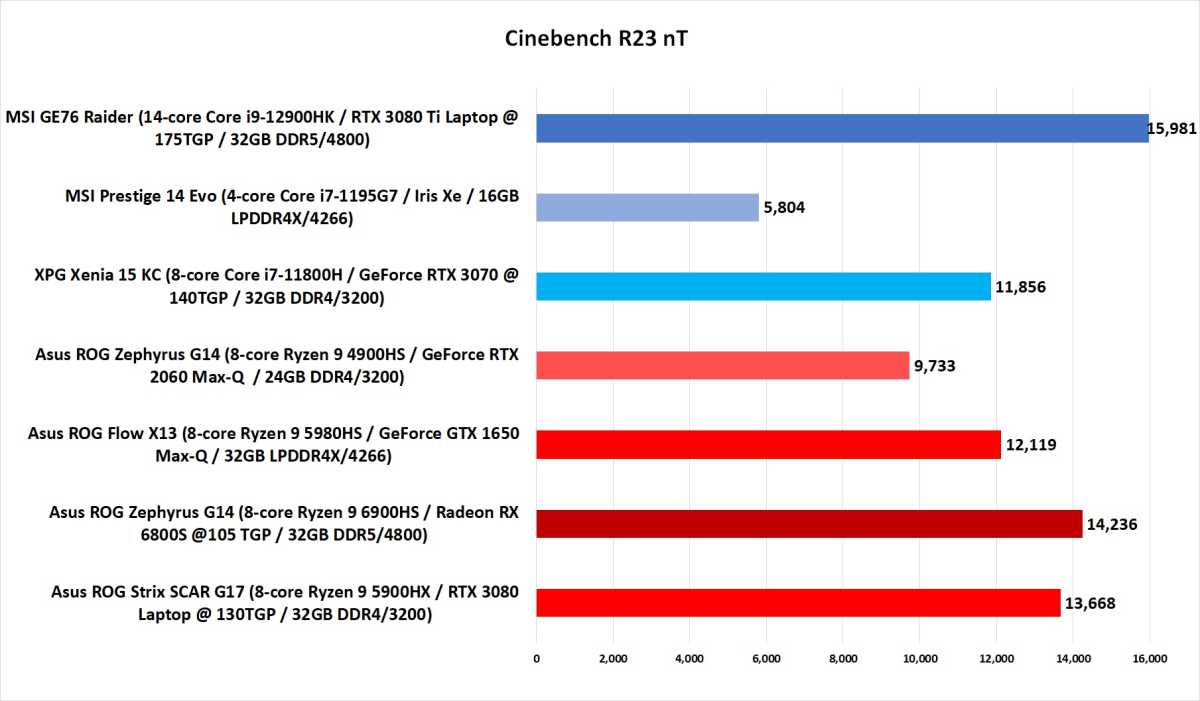
A longer bar indicates better performance. Right mouse click and select “open in new tab” to see original image.
IDG
Up next is Cinebench R23 again, but set to run on a single CPU thread. This actually probably flies closer to what most people do on a PC as few consumer applications will use all the CPU cores available to them. Single-threaded performance is also really hard to improve upon typically. The good news is the Ryzen 6000 still stays ahead of all AMD CPUs, besting both the Ryzen 9 5000 CPUs here, as well as the 11th gen Core i7-11800H (no surprise.) Intel’s Alder Lake, though, again struts across the field though with a hefty 18 percent advantage albeit in a much bigger laptop. We do think the Ryzen 9 6900HS does fairly well overall but Intel’s 12th-gen is still in front here.

A longer bar indicates better performance. Right mouse click and select “open in new tab” to see original image.
IDG
Moving on from Cinebench, we also use Chaos Group’s V-Ray 5 to measure CPU performance. It’s another 3D renderer, and one of the few applications we know that has an Academy Award. That tells you its pedigree.
Overall, we again see the 12th-gen Intel chip with 14-cores ahead of the pack, but the gap has closed with the Ryzen 9 6900HS in that tiny Asus G14 laptop just 10 percent behind it despite having significantly fewer cores. Again (and more impressively) we see the Ryzen 9 6900HS simply school all other AMD CPUs, clocking in at almost 12 percent faster than the Ryzen 9 5900HX. It doesn’t win here, but when you consider the context of the Ryzen 9 6900HS being in a smaller and much lighter laptop, it’s impressive again.

A longer bar indicates better performance. Right mouse click and select “open in new tab” to see original image.
IDG
If V-ray says Hollywood, MCU, and blockbuster movies, the free and open-source Blender is the opposite—it’s often used for small indie films and by other people who simply need access to a free (yet very powerful) 3D modeling and rendering application. For a test scene, we use the Barbership Interior CPU workload and the Cycles renderer. The 12th-gen Core i9-12900HK is again the winner, but in Blender, it’s really sweating, as it finishes rendering the scene just 5.6 percent faster than the Ryzen 9 6900HS.
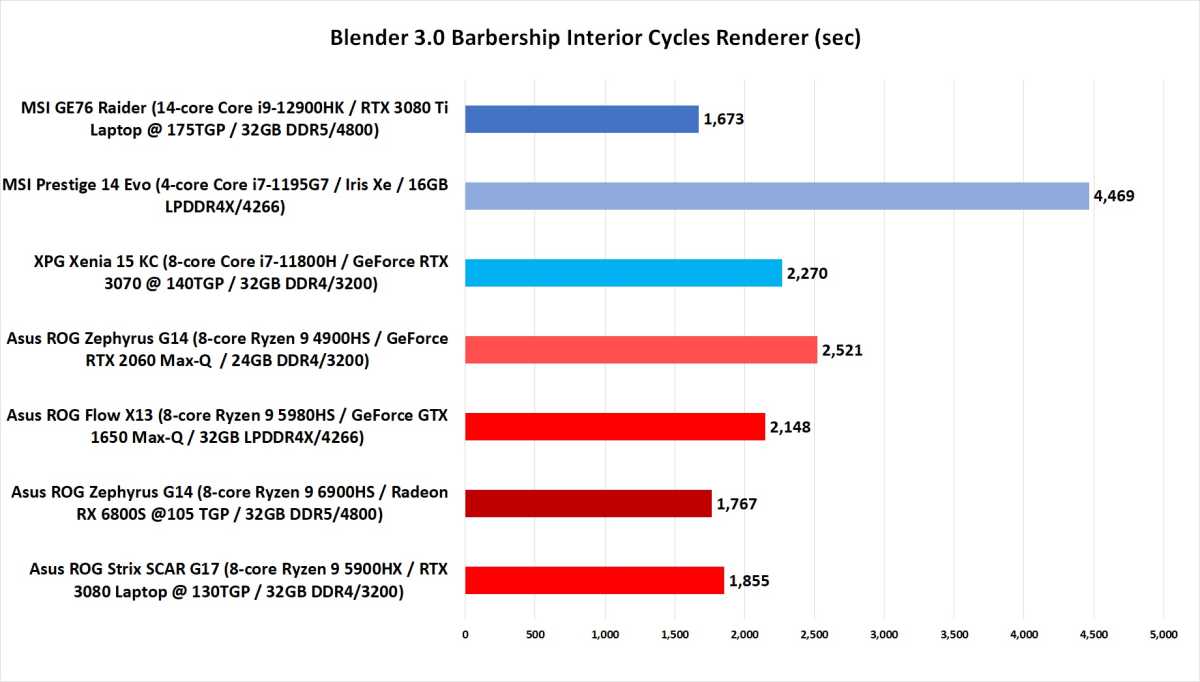
A shorter bar indicates better performance. Right mouse click and select “open in new tab” to see original image.
IDG
Encode performance
Moving on from 3D modeling, our next looks at video encoding using the free, open, and popular Handbrake encoder. For the test we use the 1.5.1 version and convert the “open-source” 4K Tears of Steel video using the H.265 MKV preset on the CPU. CPU encodes, video nerds tell us, still often yield the highest quality encodes, but they take much longer than GPU encodes. Handbrake generally likes more cores, but that’s not the only thing that matters. The winner is the 12th-gen Core i9-12900HK but it just barely gets its nose over the finish line before the Ryzen 9 6900HS crosses it. That the Ryzen 6000 CPU can slightly outpace the Ryzen 9 5900HX and breath down the neck of that 12th-gen CPU, all while being in a thin and light laptop, again says a whole lot more than simply winning the overall race to us.
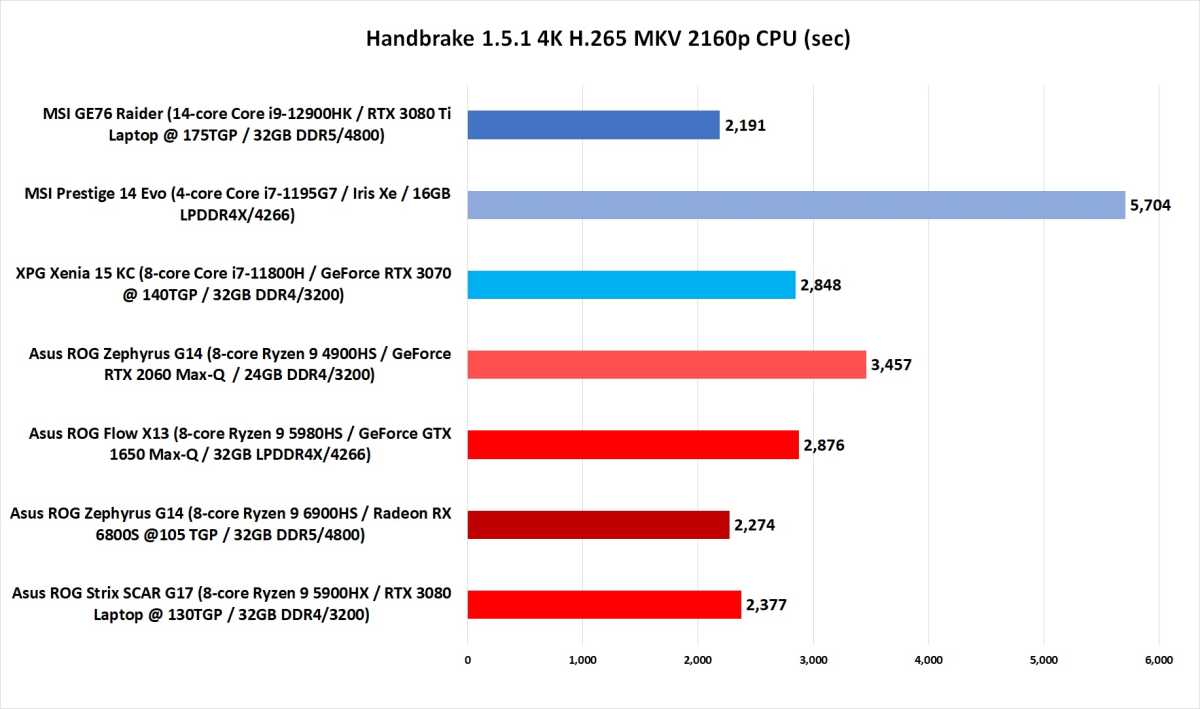
A shorter bar indicates better performance. Right mouse click and select “open in new tab” to see original image.
IDG
As we said, CPU-based encodes are what video nerds tell us they favor, but when the CPUs have built-in hardware encoders, why bother to wait? For this test, we encode the same Tears of Steel 4K video, but use the H.265 running on either Intel’s Quick Sync or AMD’s VCE features. Those video-enders, however, often need software support. For example, Intel has long been active helping to optimize Handbrake to use its QuickSync technology and it shows, as all three Intel CPUs cross the finish line first.
The Ryzen 9 6900HS doesn’t impress whatsoever, which makes us suspect the Ryzen 9 6900HS’s media engine may not be supported by the version of Handbrake we’re running yet. We’ll have to revisit this in the future with updated versions of Handbrake—and also look a little harder at the score for the Ryzen 9 5900HX, which is just funky. That score, we’ll note, isn’t due to us running it incorrectly, as we noticed its lower performance despite being run with the same settings. The takeaway here is Intel’s years of Quick Sync support in Handbrake is paying dividends but AMD’s VCE (when it’s supported, like in the Ryzen 9 5980HS) isn’t too shabby.
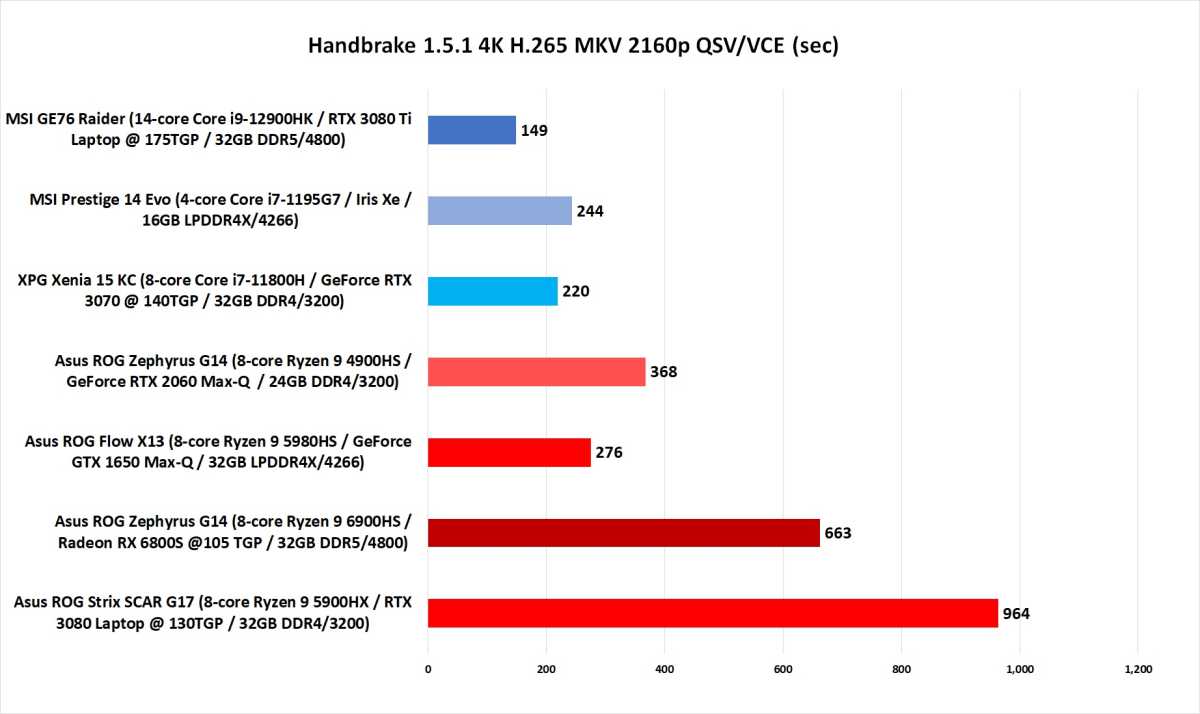
A shorter bar indicates better performance. Right mouse click and select “open in new tab” to see original image.
IDG
Adobe Creative Cloud Performance
What’s the killer app on the PC (and Mac) today? Adobe Creative Cloud. With a stable of stars ranging from Photoshop to Premiere, you basically don’t have a competing consumer and business platform if you don’t have the support of Adobe Creative Cloud. To see how well the laptop chips do here, we use workstation vendor Puget System’s set of “PugetBench” benchmarks that run the applications through a script of tasks to produce a score. First up is PugetBench Premiere.
We actually run the benchmark two ways: First with each laptop’s discrete graphics cards enabled, and with them disabled. The second method gives us a little more insight into how each laptop CPU’s integrated graphics would handle the job. It also helps remove the disparity in discrete GPUs from the picture too. As Intel and AMD push higher performance CPUs without discrete GPUs at all, it’s also actually possible this is the performance you’ll see in a laptop you’d buy.
The big, huge winner is the MSI GE76 Raider with its 12th-gen Intel CPU and GeForce RTX 3080 Ti Laptop inside. Software optimization matters and Nvidia has long worked with Adobe to support GPU-encoding and GPU-based effects, which generally gives it the edge.
The All-AMD Asus ROG Zephyrus G14, however, does relatively well. As we said, Adobe applications tend to simply run faster on Nvidia GPUs, but the Ryzen 9 6900HS and Radeon RX 6800S combo is fairly competitive with the Ryzen 9 5900HX and GeForce RTX 3080 inside of a 6 pound laptop. With the discrete GPUs disabled, the Ryzen 9 5900HX manages to muscle by the Ryzen 9 6900HS but it’s pretty close.
Unfortunately, we were unable to install the scripts for the Ryzen 9 4900HS laptop. We also decided against running it on the 2.8 pound MSI Prestige 14 Evo for time’s sake. PugetBench also recommends having a minimum of 32GB to run the benchmark so it’s probably for the better.
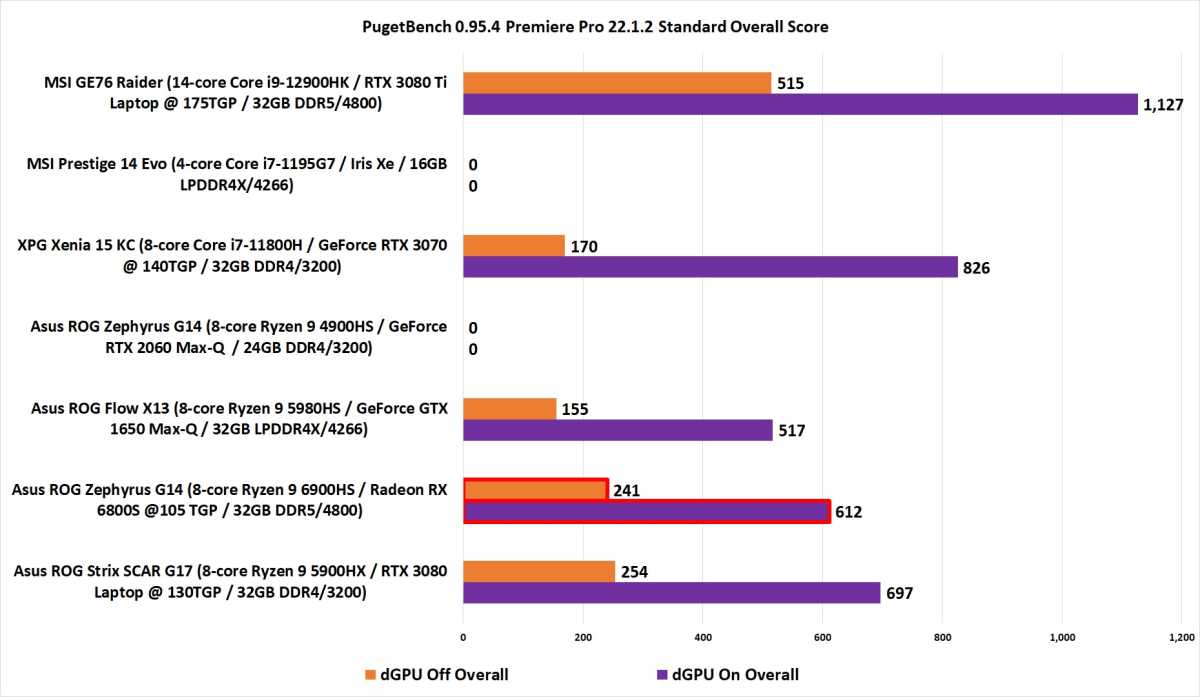
A longer bar indicates better performance. Right mouse click and select “open in new tab” to see original image. A zero indicates the test was unable to run.
IDG
Huge, sprawling modern applications like Premiere mean one set of scripts doesn’t tell you the whole story, and performance may vary depending on the task you do in the application. To get a fuller picture, we also run UL’s Procyon Video Editing test which, like PugetBench, tasks Premiere with exporting video using four different video codecs from a timeline with effects like Lumitri Color adjustments added to the video. Procyon doesn’t have the steep requirements of PugetBench either. Like PugetBench, we ran Procyon Video Editing with the discrete GPUs enabled and disabled.
The winner is again Intel’s Core i9-12900HK and GeForce RTX 3080 Ti combo but the Ryzen 9 6900HS and Radeon RX 6800S is surprisingly competitive with the larger Ryzen 9 5900HX and GeForce RTX 3080 Laptop combination. With the discrete GPUs turned off, the Ryzne 9 6900HS and its RDNA2 graphics are solidly in front of all others except Intel’s 12th-gen behemoth.

A longer bar indicates better performance. Right mouse click and select “open in new tab” to see original image.
IDG
If a working photographer had to choose between Photoshop and Lightroom Classic, we bet the majority would pick Lightroom Classic. It is, after all, the application that makes it possible to slog through the 4,000 photos they took at an event.
Intel etches solid wins this category again with the 12th-gen laptop a solid front runner, but the 4 lbs. Xenia 15 KC with its 11th-gen Core i7-11800H also outpaces Team Red. The good news for the Ryzen 9 6900HS is it’s at least in front of all other Ryzen CPUs, including the larger Ryzen 9 5900HX laptop.
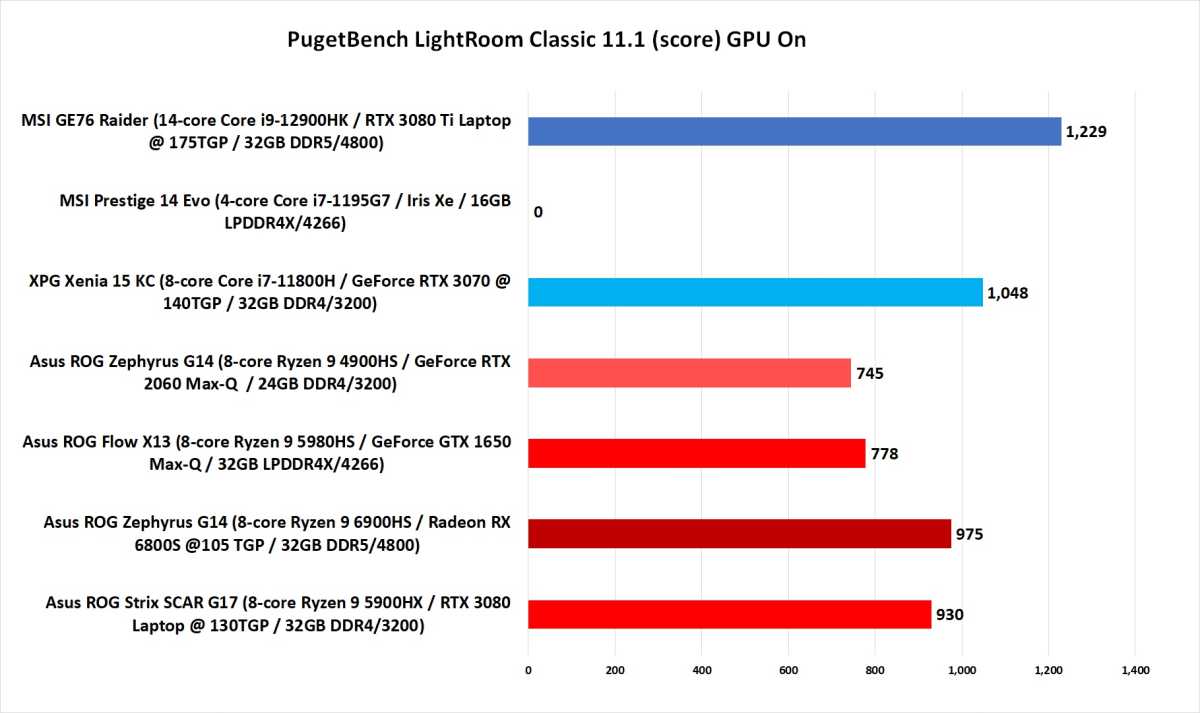
A longer bar indicates better performance. Right mouse click and select “open in new tab” to see original image. A zero indicates the test was unable to run.
IDG
We just trash-talked Photoshop a bit, but we admit, it’s the application that launched a million beautifully photoshopped memes. For this test, we run PugetBench’s Photoshop with the discrete GPU enabled and disabled, and the Ryzen 9 and Radeon RX 6800S pull off decent scores. Although it can’t overpower the big, fast GE76 Raider’s 12th-gen Core i9 and 3080 Ti combo, the diminutive ROG Zephyrus G14 runs solidly ahead of the rest of the pack. We’ll be interested to see how the Intel and Nvidia combination do when more constrained by thinner and lighter laptops.

A longer bar indicates better performance. Right mouse click and select “open in new tab” to see original image. A zero indicates the test was unable to run.
IDG
Our final Adobe Creative Cloud test uses UL’s Procyon Photo Editing benchmark, which combines Photoshop and Lightroom Classic. The test is lighter duty than PugetBench and we see the Ryzen 9 and Radeon RX 6800S in a solid place. With the discrete GPU on, it’s essentially tied with the GeForce RTX 3070-based laptop, and just about 13 percent behind the GE76 Raider. With the discrete GPU off, the Ryzen 9 6900HS is slightly faster than the Ryzen 9 5900HX and has the 12th-gen Core i9 looking nervously in its rear view mirror.
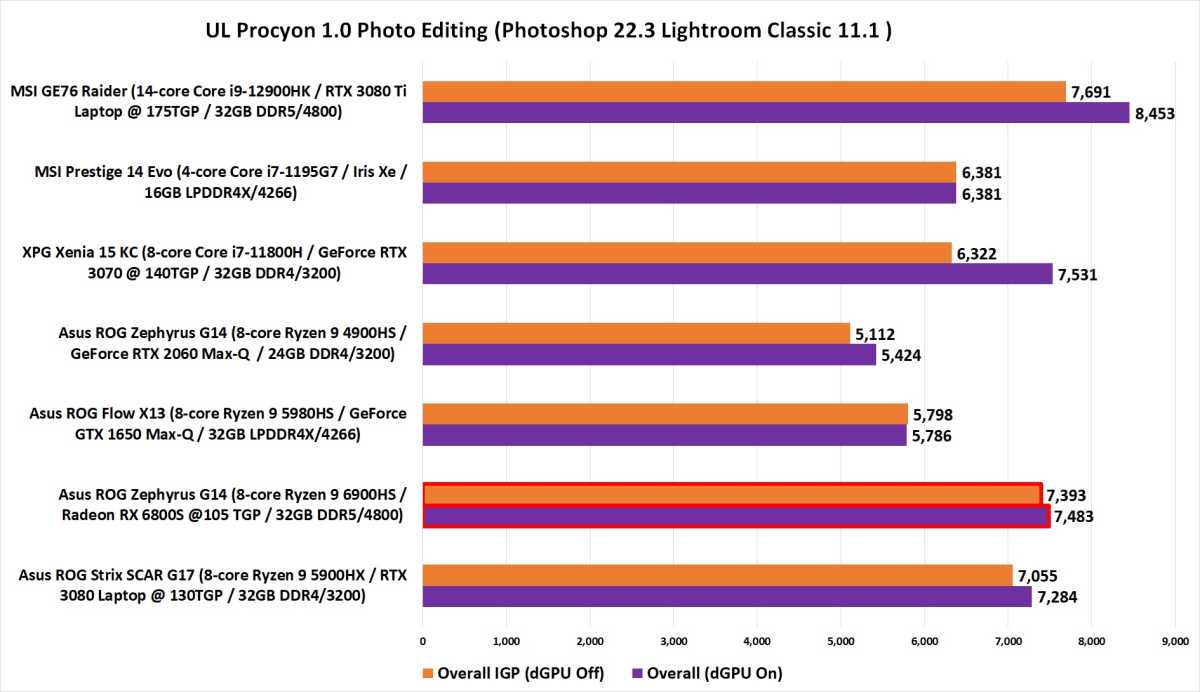
A longer bar indicates better performance. Right mouse click and select “open in new tab” to see original image.
IDG
Office 365 Performance
In the world we live in, a ton more people run Microsoft Office 365 than Adobe Creative Cloud. Sure, that may not be by choice, but if you live the cubicle life and find joy in hitting reply-all on company-wide emails, it matters.
To gauge performance in Office 365, we use UL’s Procyon Office, which runs Word, Excel, PowerPoint, and Outlook through a set of scripted tasks in the way you might run it. That is, all four applications are open at once and switched between.
Pretty much any computer can run Microsoft Office 365 just fine. That doesn’t mean there isn’t a faster one though. The winner is the 12th-gen Intel laptop overall which shouldn’t surprise anyone. The Ryzen 9 6900HS still does relatively well but there are some odd results. While it seems to run Word almost as fast as the 12th-gen laptop, PowerPoint is bizarrely off the pace with the ROG Zephyrus G14 actually being the slowest laptop here—in PowerPoint. That’s fine though as it seems to make up for it Word and Excel.
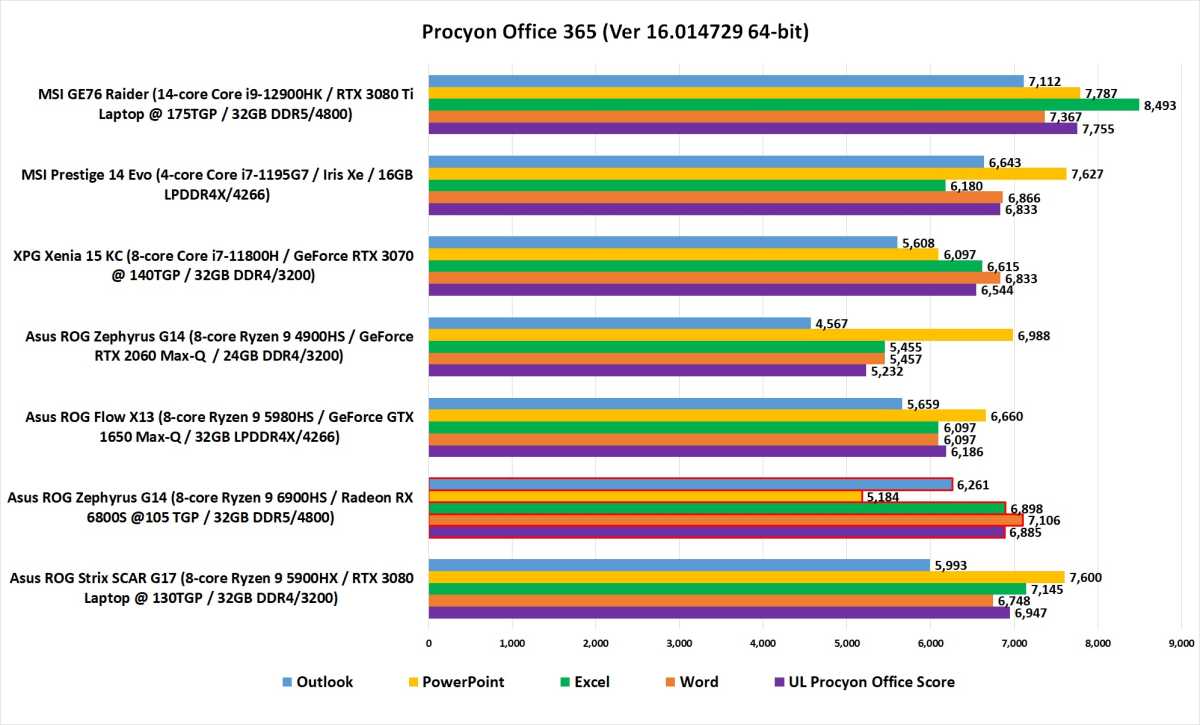
A longer bar indicates better performance. Right mouse click and select “open in new tab” to see original image.
IDG
Office 365 may seem like a boringly productive tool but we can no longer say that about Excel. After all, it’s a legit esport now with even ESPN taking notice. To celebrate Excel’s time to shine, we asked a top Excel esport competitor to provide us with a spreadsheet he uses in real-life to measure performance on a PC. Our full interview with Jason Moore gets into all sorts of interesting nitty-gritty details about the life of an Excel power user, but the spreadsheet is legit since it’s about as real-world as you can get.
We’re still trying to figure what makes Excel zing and we’ve seen some real head-scratching results here, such as a 4-core Core i7-1195G7 with 16GB of RAM out perform 8-core Ryzen CPUs with 32GB of RAM. And while that 8-core 11th-gen CPU looks decent, we’ve also seen a 6-core 9th-gen Core i7-9750H turn in about the same score.
Trying to figure out why the results are all over the map would be fun, but in the real-world, that doesn’t matter. The only thing that matters is waiting to get a result so you can find out where to invest your money. Time literally is money in the world where Excel lives. So take that glory-seeking Photoshop.
The good news for Ryzen 9 6900HS is its performance. It finishes recalculating 38 percent faster than the Ryzen 9 5980HS, and 35 percent faster than the Ryzen 9 5900HX. It doesn’t outpace the mighty 12th-gen Core i9-12900HK, which finishes the task in 23 percent less time in its much larger laptop, but the new Ryzen 6000 is solidly faster than all others. Why? Who cares, we just want to make money.
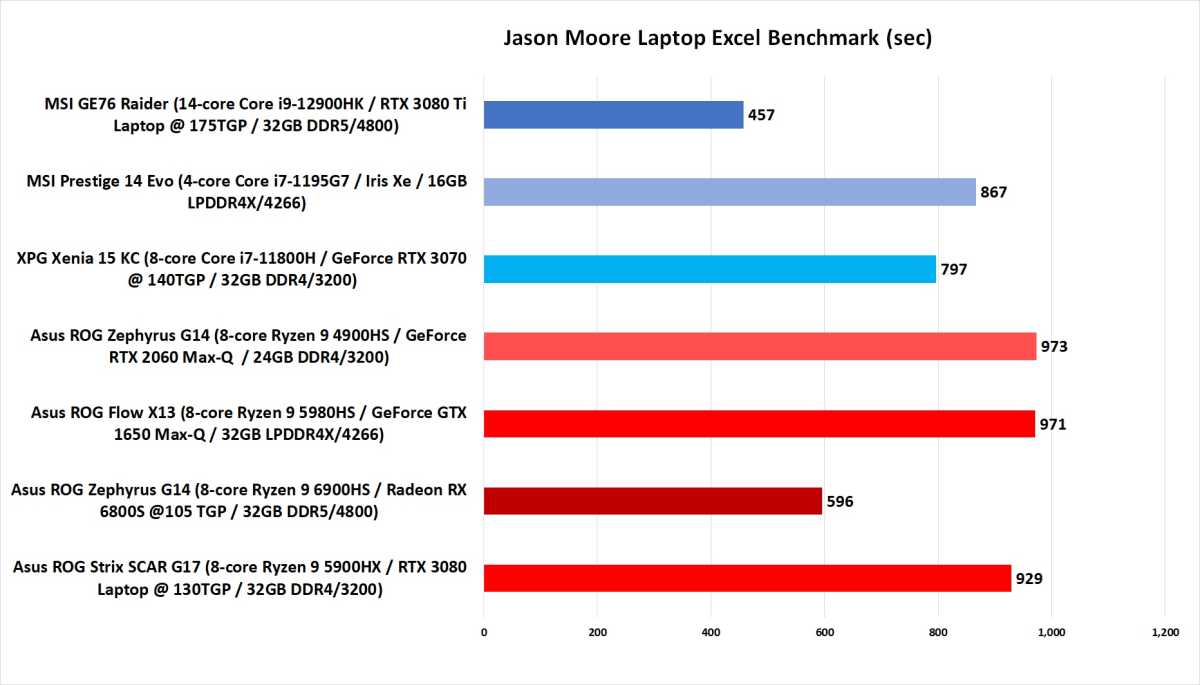
A shorter bar indicates better performance. Right mouse click and select “open in new tab” to see original image.
IDG
Browser performance
Arguably the one application you can’t do without today is the browser. Having a snappy browsing performance is often how people judge how fast a PC is so we tasked the laptops with running Google Chrome 98 through four popular browser benchmarks. These tests would normally be used to gauge actual browser performance but since we’re running the exact same browser version on each laptop, the notebook hardware is what’s moving the performance needle around. The winner again is the big fast GE76 Raider and its 12th-gen Core i9. The Ryzen 9 6900HS is solidly in second place, however, and mostly outperforms all other CPUs not named 12th gen.
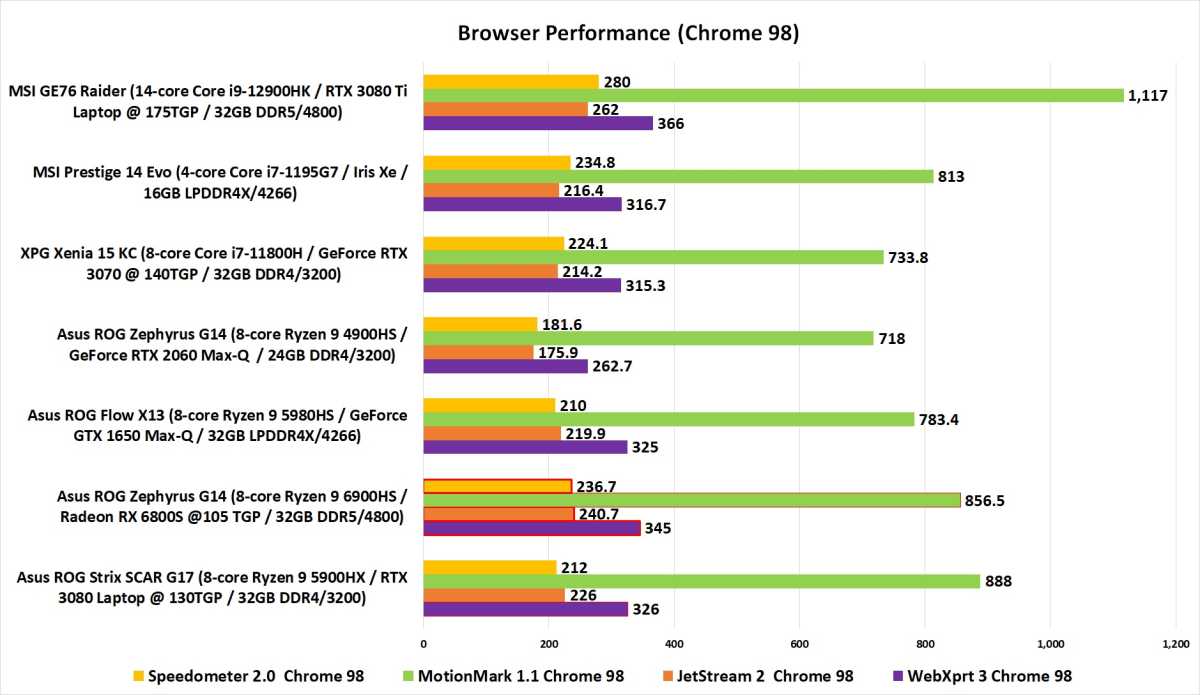
A longer bar indicates better performance. Right mouse click and select “open in new tab” to see original image.
IDG
AI performance
AI use on the PC is arguably still very thin, but what we’ve seen of it tells us it’s only going to get more important. AI on our phones and in the cloud for image recognition is proving to be invaluable, so why not do it on your PC? To dip our toe into that, we run Nero Score, which is a free AI benchmark based on Intel’s OpenVino framework. Yes, Intel’s OpenVino. Intel has invested millions in this area and you can consider this a strong home field advantage for Intel CPUs.
How much of a home field advantage? Obviously the 12th-gen Alder late laptop knocks it out of the park, but in the AI phototagging test, the Core i7-1195G7 is slightly faster than the Ryzen 9 5900HS. It wasn’t going to win anyway but the good news for the Ryzen 9 6900HS is it far outperforms the Ryzen 9 4900HS and the Ryzen 9 5980HS, beating them by 67 percent and 38 percent respectively. It also shows a sizeable increase over older Ryzen CPUs in Nero’s AVC decode/encode test as well. As the world heads toward more AI use on the PC, this is at least a good step for AMD.
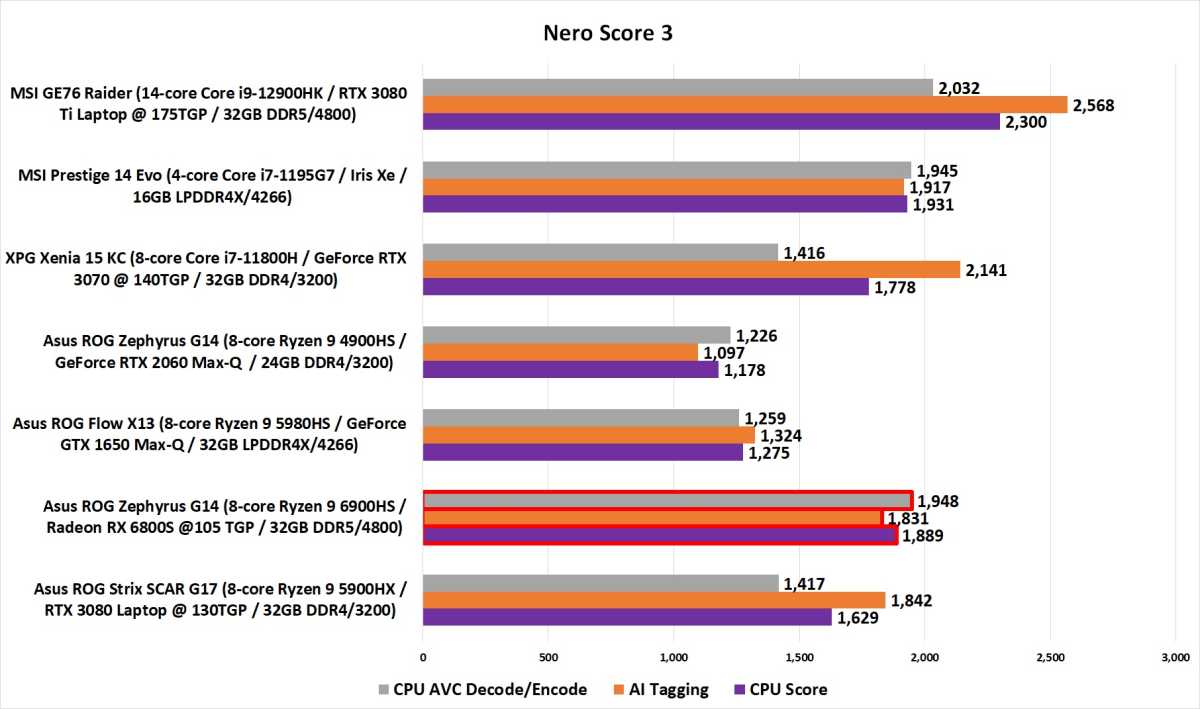
A longer bar indicates better performance. Right mouse click and select “open in new tab” to see original image.
IDG
Geekbench performance
Our next benchmark is the stupidly popular Geekbench 5 benchmark. It’s a suite of short programming loops built around tasks such as text compression, encryption, and JPG decompression. The Ryzen 9 6900HS is the solid second place finisher overall and again shows especially well against previous-gen Ryzen 5000-based laptops in multi-core performance.

A longer bar indicates better performance. Right mouse click and select “open in new tab” to see original image.
IDG
Besides testing CPU-based tasks, Geekbench also has a mode to measure popular tasks using OpenCL on the GPU. For our test, we ran Geekbench on both the integrated graphics of the CPUs as well as the discrete GPU. The Radeon RX 6800S gets paved over by the higher-wattage GeForce GPUs but there’s a good glimmer of light on the IGP test.
The Radeon RDNA 2 architecture in the Ryzen 9 6900HS defeats all, including the 12th-gen laptop’s DDR5-fed graphics to the tune of 61 percent. It’s also about 107 percent faster than the Radeon IGP in the Ryzen 9 5980HS.

A longer bar indicates better performance. Right mouse click and select “open in new tab” to see original image.
IDG
Gaming performance
That brings us to the gaming performance of the Radeon RX 6800S. Modern laptop GPUs are largely gated by the power they can consume. The higher the wattage, the higher the performance generally. To us, the question here isn’t whether the 110 watt Radeon RX 6800S in the tiny ROG Zephyrus G14 can outpace the 175 watt GeForce RTX 3080 Ti in the big 12th-gen GE76 Raider. It simply can’t. The question is how it performs against GPUs closer to its wattage envelope.
Overall, we’d say the Radeon RX 6800S performs quite well. It can run with and sometimes outperform the 130 watt GeForce RTX 3080 Laptop GPU in the Scar G17 laptop, as well as the 140 watt GeForce RTX 3070 Laptop GPU in the Xenia 15 KC. What makes that all the more impressive is just how compact and light the all-AMD ROG Zephyrus G14 is at only 3.7 lbs. We suspect putting a GeForce RTX 3080 into a laptop as tiny as the G14 could give the advantage to the Radeon.
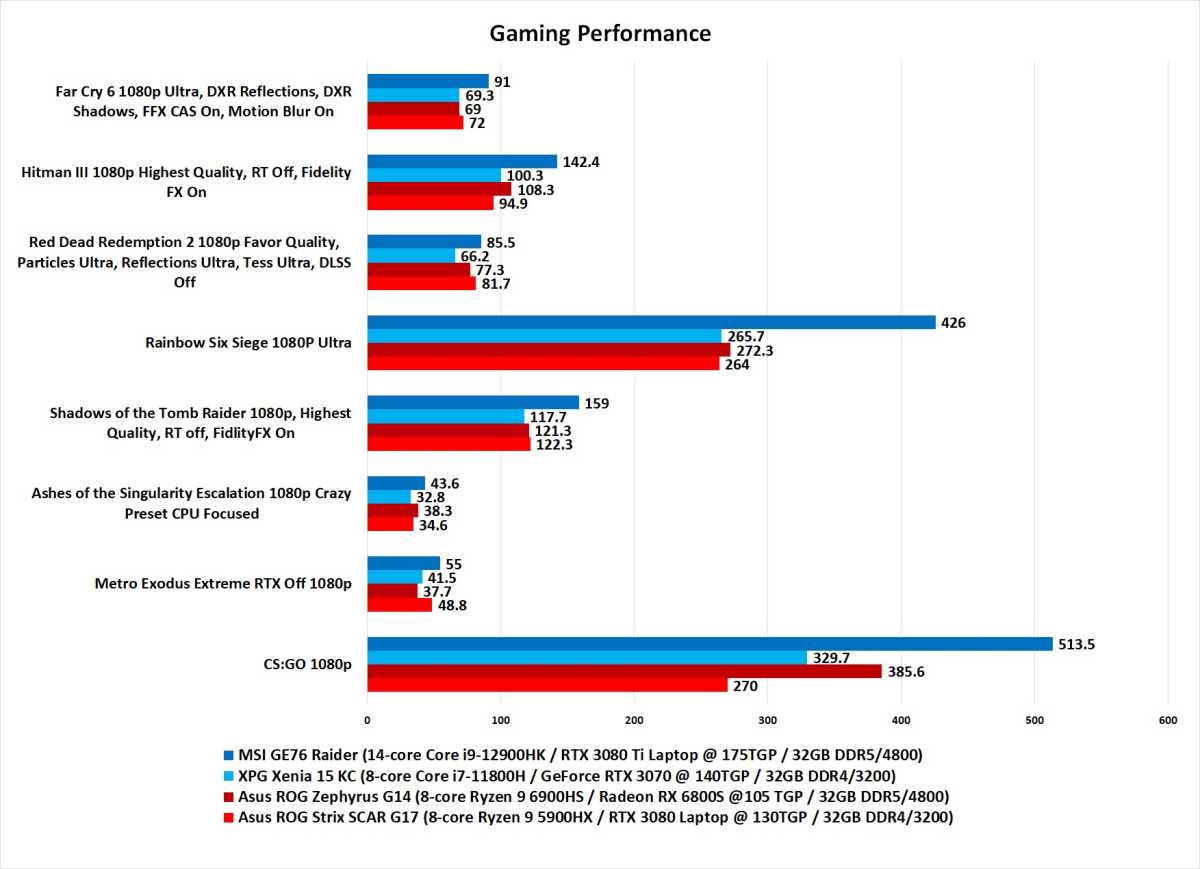
A longer bar indicates better performance. Right mouse click and select “open in new tab” to see original image.
IDG
To get one more opinion on where the performance of the Radeon RX 6800S falls, we also run UL’s 3DMark Time Spy benchmark, which again tells us the GPU is in the neighborhood of a GeForce RTX 3070 Laptop or GeForce 3080 Laptop GPU with larger power budgets. We’ll have to see where the chips fall when we test more thin and light laptops with those GPUs, but we’re pretty sure the power constraints are likely to make an interesting contest. The Radeon RX 6800S has great gaming chops.
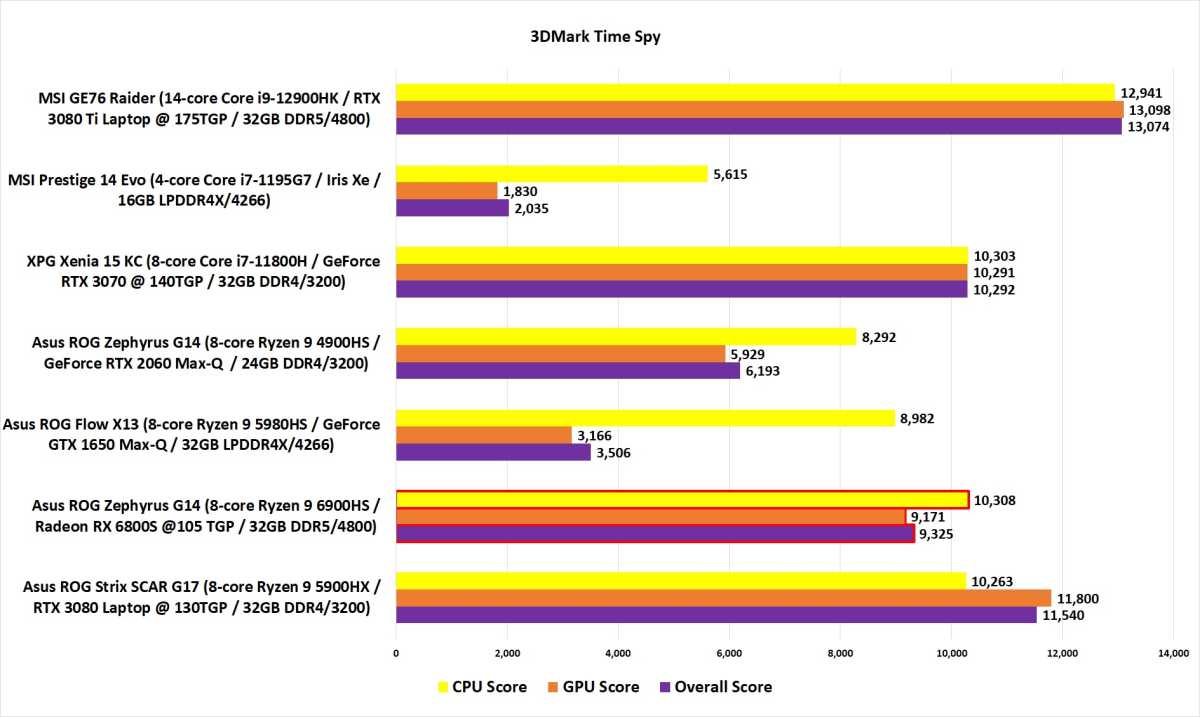
A longer bar indicates better performance. Right mouse click and select “open in new tab” to see original image.
IDG
Most people who buy a laptop with a powerful discrete GPU won’t use the integrated graphics for gaming, but one of the most exciting developments with Ryzen 6000 is the use of integrated Radeon RDNA 2 graphics cores and DDR5 RAM. To get a glimpse of where the Ryzen 6000’s integrated graphics performance falls, we run 3DMark Time Spy on it. The winner: The RDNA 2-based Radeon inside of the Ryzen 9 6900HS which comes in a whopping 33 percent faster than the IGP in Intel’s 12th-gen Core i9-12900HK.
What this means is you might get far more playable frame rates at 1080p with game settings turned down to low if it’s a milder game. For laptops with discrete GPUs it’s no big deal, but desktop APUs based on new RDNA 2 graphics cores may be quite impressive for budget gamers when they arrive.
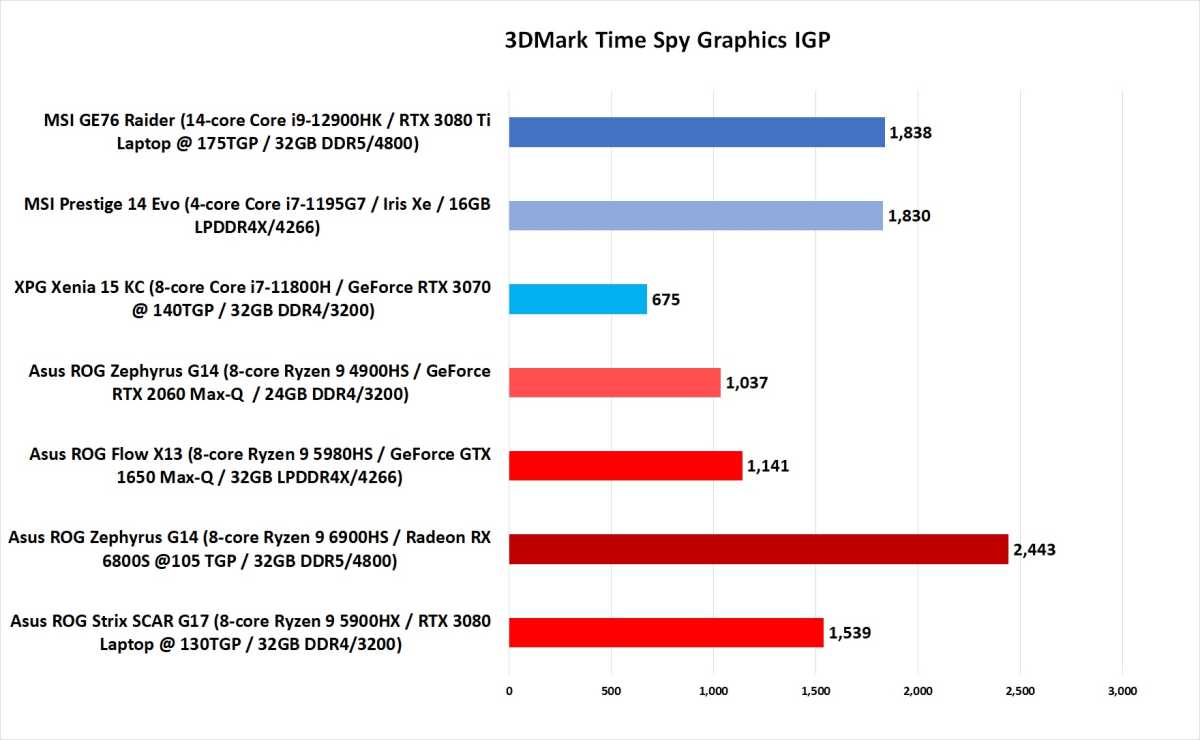
A longer bar indicates better performance. Right mouse click and select “open in new tab” to see original image.
IDG
Our last 3DMark results looks at the PCIe performance of the laptops. AMD’s previous designs limited the GPU to 8 lanes of PCIe Gen 3, which was apparently done to save power. Today, that’s not enough bandwidth to connect a high-performance RDNA 2 GPU to the CPU, so AMD has increased it to PCIe Gen 4, which is also the same decision Intel made for its new 12th-gen CPUs. As we can see from 3DMark’s PCIe feature test, the CPU to GPU bandwidth is about 13GBps and a very hefty improvement over the previous design’s 6GBps.
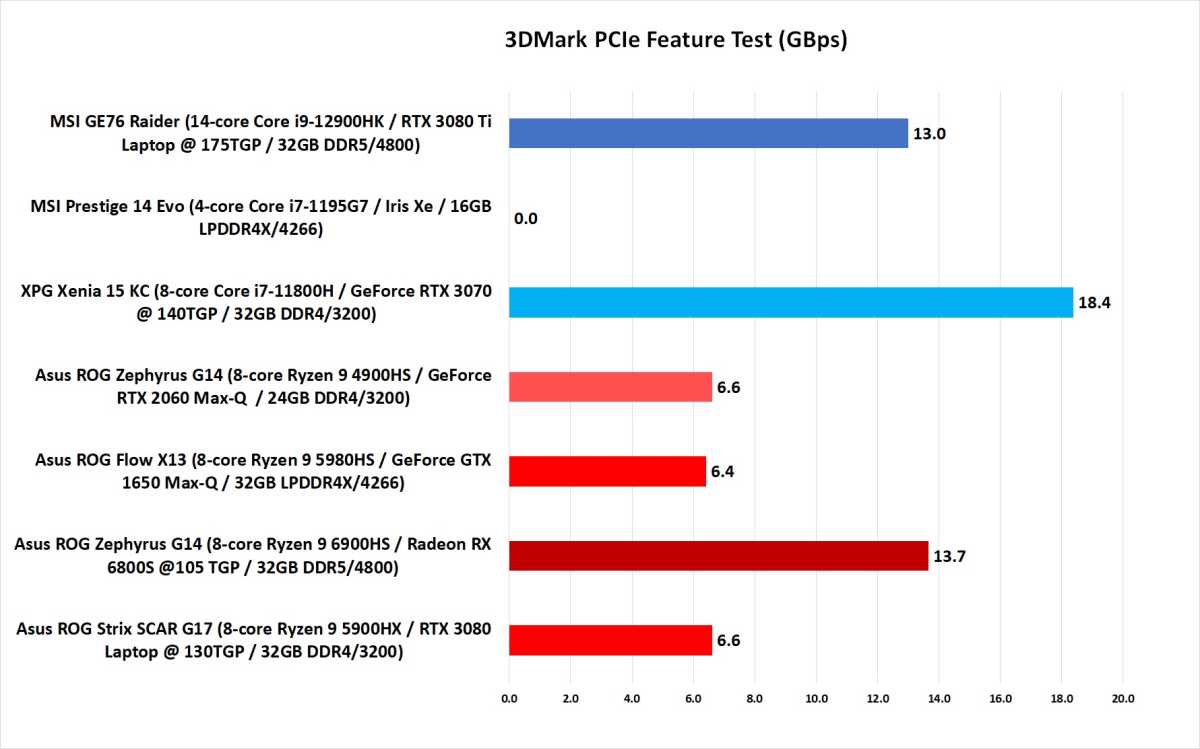
A longer bar indicates better performance. Right mouse click and select “open in new tab” to see original image.
IDG
Battery life
Battery comparisons of a laptop are fraught with caveats because so many factors impact battery life other than CPU. The screen resolution and size of the battery, for example, tangibly move the needle in how long a laptop will run. Still, you want to see the results for these laptop configurations, so we ran our standard battery run test, which loops the Tears of Steel 4K video in airplane mode, with earbuds plugged in at 50 percent volume and the screen brightness set to a relatively bright 250 to 260 nits. The chart below denotes the size of the battery and resolution of the panel for reference.
The best performance should be of no surprise: The MSI Prestige 14 Evo is a light-weight ultra portable without discrete graphics and turns in a run time just over 10 hours. Most of the laptops with discrete GPUs land at just over six hours of run time, which is fair for this class of notebook. Video playback, however, is probably one of the easiest tasks a laptop can do today. We plan additional battery tests as time permits to see if AMD’s claim of offering “hours” of endurance advantage is real or not. For now, just know running video will give you fair runtime, but running the GPU or CPU hard will greatly diminish how long your laptop stays powered-up in the real world.
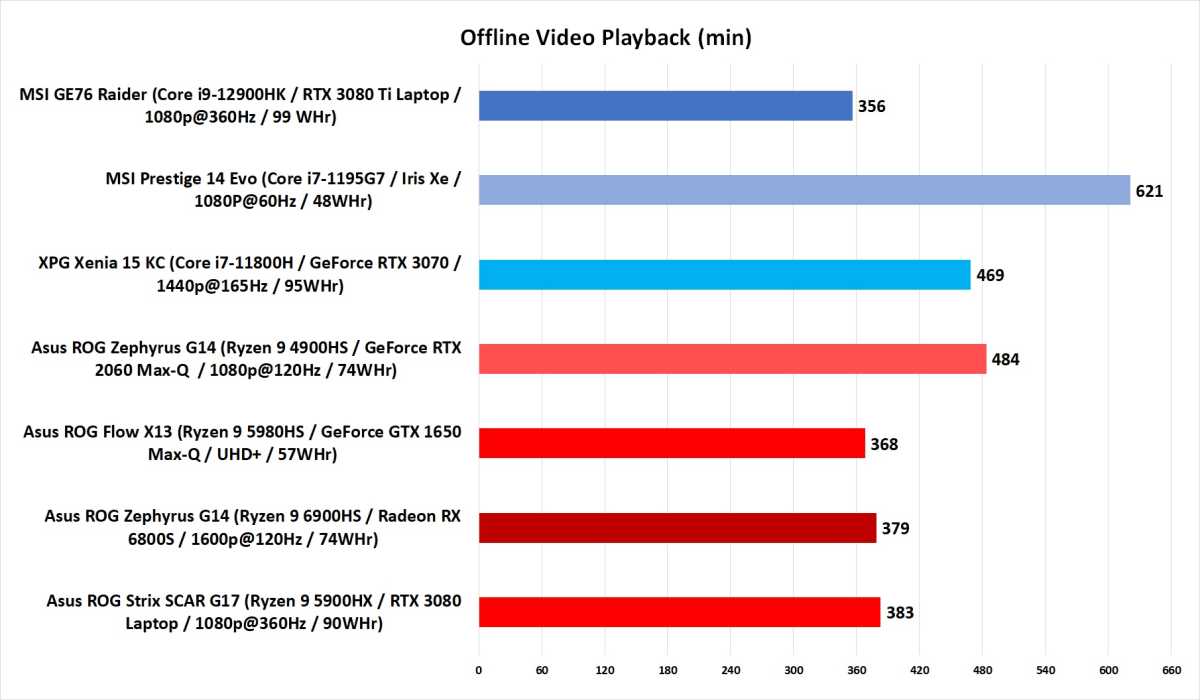
A longer bar indicates better performance. Right mouse click and select “open in new tab” to see original image.
IDG
Conclusion
We’ll close out our review where we began, with Cinebench, but this time using the older R20 version. For this comparison we run it on a single-thread then move all the way up to the maximum number of threads on a CPU. Below, you can see the results of the Ryzen 9 6900HS in a thin and light gaming laptop against a Ryzen 9 5900HX in a thick and heavy gaming laptop. The darker red bars represent performance of the Ryzen 6000, while the lighter red are the Ryzen 5000. While you might just shrug, the key take away from the results is a thin and light laptop is actually slightly outperforming one of the faster CPUs of 2021 in a much thicker, much heavier laptop. That’s worth celebrating.

A longer bar indicates better performance. Right mouse click and select “open in new tab” to see original image.
IDG
A more reasonable comparison would be the Ryzen 9 6900HS versus the Ryzen 9 5980HS, which is closer to its class. To help you see the increase in performance, we’re only showing the percent increase per-thread from the Ryzen 5000 to the Ryzen 6000. As you can see, the newer Ryzen 9 6900HS is pushing pretty respectable speed increase compared to what was the best Ryzen 9 HS-class CPU of last year.
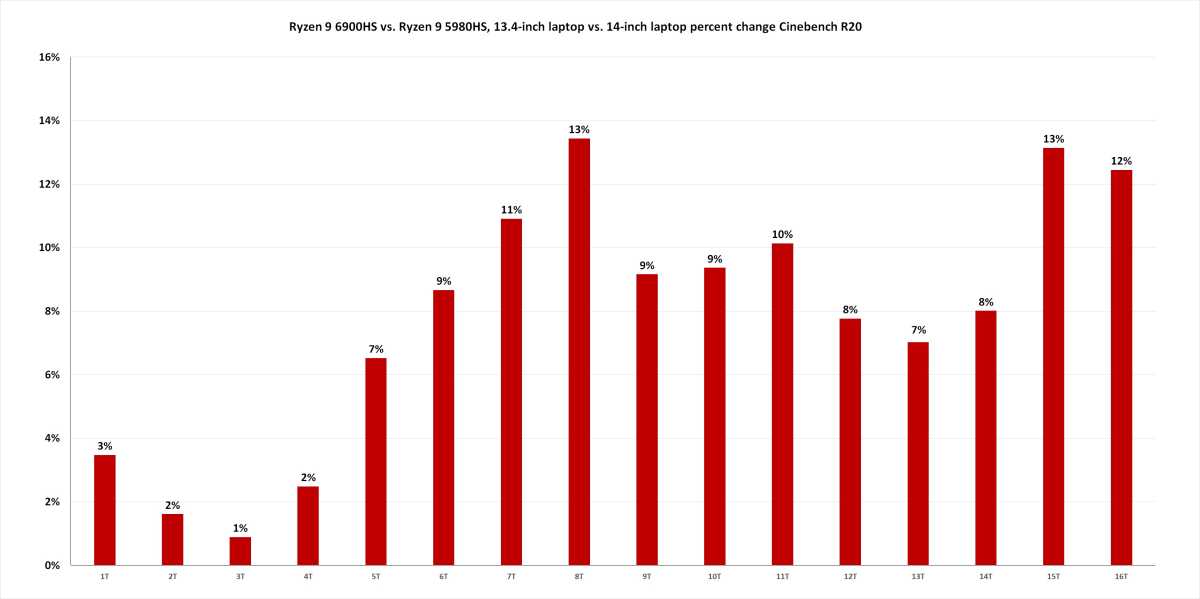
A longer bar indicates better performance. Right mouse click and select “open in new tab” to see original image.
IDG
You’re probably wondering how the Ryzen 9 6800HS compares to Intel’s 12th-gen Core i9-12900HK, which we’ll show you below—but not without mentioning yet again that we’re looking at a very thick and heavy laptop versus a thin and light one. Still, it’s all blue here because there’s nothing the 12th gen Core i9-12900HK gives up against the new Ryzen 9 6900HS. The laptop is also almost twice as heavy too, however.
How Intel’s 12th-gen parts compare to Ryzen 6000 really can’t be determined until we’ve seen more Alder Lake laptops, especially those inside of thin and light laptops. The initial round of 12th-gen laptops sent to reviewers focused on heavy, gaming-grade H-series chips. It’s entirely possible that with the tighter thermal and power constraints of a thin and light laptop, Intel’s 12th-gen chips and AMD’s Ryzen 6000 mobile CPUs might be a lot closer than we expect them to be. At the same time, the Ryzen 6000 offers a hefty improvement in graphics performance, and when paired with its Radeon partner, it’s likely to close the gap even more.
The upshot in all this it looks like it looks like we still have a ball game when it comes to high-performance laptop processors, so don’t leave your seats and head for the exits just yet.

A longer bar indicates better performance. Right mouse click and select “open in new tab” to see original image.
IDG
One of founding fathers of hardcore tech reporting, Gordon has been covering PCs and components since 1998.
For all the latest Technology News Click Here
For the latest news and updates, follow us on Google News.

